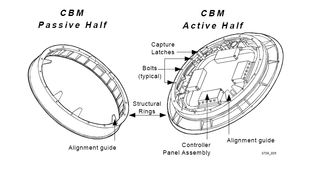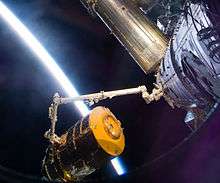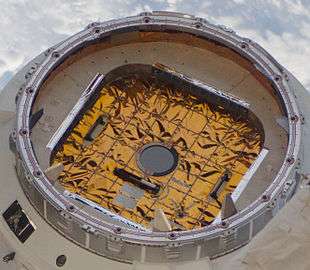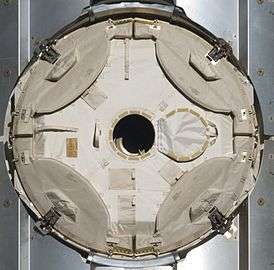Common Berthing Mechanism
The Common Berthing Mechanism (CBM) is a berthing mechanism primarily used to connect pressurized elements within the US Orbital Segment of the International Space Station. It roughly corresponds to the docking ports that are used to join such elements within the Russian Orbital Segment. It was developed by Boeing at the Marshall Space Flight Center (MSFC) in Huntsville, Alabama under contract NAS15-10000 from the National Aeronautics and Space Administration (NASA).[1]


The CBM system is a combination of structural, mechanical and control components that perform the capture, closure, and passive structural connection between two pressurized modules. The total CBM system is composed of two distinct sets of equipment: the active and passive halves. The active half [ACBM] supports the mechanical and control elements which effect the actual capture and closure functions of the berthing operations. The passive half [PCBM] contains the inert elements required to complete the berthing and closure action. It also contains the seals effecting pressurized capability at the Module/Module interface.[2]
The ACBM was developed in response to specification S683-29902 (CAGE 3A768). The PCBM was developed under specification S683-28943 (CAGE 3A768). According to the specifications, the CBM provides a Module/Module clear passage square with rounded corners with a width of 50"[3], which is large enough to accommodate a standard hatch and allow International Standard Payload Racks to be passed between modules. Using such racks, payloads can be pre-configured and transported to the station aboard a variety of logistics modules. Once the hatches have been opened and the Module/Module vestibule configured, electrical, data, and fluid lines can be manually connected by the crew in a "shirt-sleeve" environment.
In addition to Module/Module attachment locations, the CBM is also used as a structural/mechanical/utility interface (e.g., for the base of the Z1 truss) and for docking adapters at various locations.
Operation
On radial ports, the 4 covers ('petals') on the ACBM open to expose the 4 sets of latches and alignment guides. For any ACBM location, the PCBM is aligned with ACBM using a tele-robotic device (of which several varieties exist). Latches engage and retract. When fully latched, 16 bolts are driven (under remote control) from the active side into the passive side. Bolts are tightened in multiple stages, allowing the temperatures to equalise as necessary. Bolt loads are sensed by a load cell within each of the 16 units.
Uses on the ISS
Uses of the CBM (as of late 2018) are tabulated below.
| PCBM Element | Time Frame | On-orbit CBM Berth | Permanent Delivery | Logistics | ACBM Element | Orientation During Berth | Notes | Sources |
|---|---|---|---|---|---|---|---|---|
| PMA-1 | 09/1998 | No | Yes | No | Node 1 | Aft | Factory Mate | [4] |
| PMA-2 | 09/1998 | No | Yes | No | Node 1 | Forward | Factory Mate | [4] |
| FGB Zarya | 11/1998 | No | Yes | No | N/A | N/A | First Launch | [4] |
| Node 1 (Unity) | 12/1998 | No | Yes | No | N/A | N/A | APAS Mate | [4] |
| Service Module (Zvezda) | 07/2000 | No | Yes | No | N/A | N/A | APAS Mate | [4] |
| Z1 | 10/2000 | Yes | Yes | No | Node 1 | Zenith | [4] | |
| PMA-3 | 10/2000 | Yes | Yes | No | Node 1 | Nadir | [4] | |
| PMA-2 | 02/2001 | Yes | No | No | US Lab | Forward | [4] | |
| U.S. Lab (Destiny) | 02/2001 | Yes | Yes | No | Node 1 | Forward | [4] | |
| PMA-3 | 03/2001 | Yes | No | No | Node 1 | Port | [4] | |
| MPLM (STS-102) | 03/2001 | Yes | No | Yes | Node 1 | Nadir | [4] | |
| MPLM (STS-100) | 04/2001 | Yes | No | Yes | Node 1 | Nadir | [4] | |
| Airlock (Quest) | 06/2001 | Yes | Yes | No | Node 1 | Starboard | [4] | |
| MPLM (STS-105) | 08/2001 | Yes | No | Yes | Node 1 | Nadir | [4] | |
| Russian Docking Compartment & Airlock | 09/2001 | No | Yes | No | N/A | N/A | APAS Mate | [4] |
| MPLM (STS-108) | 12/2001 | Yes | No | Yes | Node 1 | Nadir | [4] | |
| MPLM (STS-111) | 06/2002 | Yes | No | Yes | Node 1 | Nadir | [4] | |
| MPLM (STS-114) | 07/2005 | Yes | No | Yes | Node 1 | Nadir | [4] | |
| MPLM (STS-121) | 06/2006 | Yes | No | Yes | Node 1 | Nadir | [4] | |
| PMA-3 | 08/2007 | Yes | No | No | Node 1 | Nadir | Intermittent faults while unbolting | [4][5] |
| Node 2 (Harmony) | 10/2007 | Yes | Yes | No | Node 1 | Port | [6] | |
| PMA-2 | 11/2007 | Yes | No | No | Node 2 | Starboard | [4] | |
| Node 2 (Harmony) + PMA-2 | 11/2007 | Yes | No | No | US Lab | Forward | [4] | |
| European Research Laboratory (Columbus) | 02/2008 | Yes | Yes | No | Node 2 | Starboard | [4] | |
| ELM-PS | 03/2008 | Yes | Yes | No | Node 2 | Zenith | [4] | |
| Japanese Experiment Module (Kibo) | 05/2008 | Yes | Yes | No | Node 2 | Port | [4] | |
| ELM-PS | 05/2008 | Yes | Yes | No | JEM | Zenith | [4] | |
| MPLM (STS-126) | 11/2008 | Yes | No | Yes | Node 2 | Nadir | [4][7] | |
| PMA-3 | 08/2009 | Yes | No | No | Node 1 | Port | [4] | |
| MPLM (STS-128) | 08/2009 | Yes | No | Yes | Node 2 | Nadir | Bolt 4-1, Node 2 Nadir: high torque on berth, jammed on deberth (replaced IVA) | [4][8] |
| ISS-HTV1 | 09/2009 | Yes | No | Yes | Node 2 | Nadir | [4][9] | |
| MRM-2 | 11/2009 | No | Yes | No | N/A | N/A | APAS Mate | [4] |
| PMA-3 | 01/2010 | Yes | No | No | Node 2 | Zenith | [4] | |
| Node 3 (Tranquility) + Cupola (STS-130) | 02/2010 | Yes | Yes | No | Node 1 | Port | Multiple bolt jams during Cupola deberth | [4][10] |
| PMA-3 | 02/2010 | Yes | No | No | Node 3 | Port | [4] | |
| Cupola | 02/2010 | Yes | Yes | No | Node 3 | Nadir | [4] | |
| MPLM (STS-131) | 04/2010 | Yes | No | Yes | Node 2 | Nadir | [4][11] | |
| MRM-1 | 05/2010 | No | Yes | No | N/A | N/A | APAS Mate | [4] |
| ISS-HTV2 | 01/2011 | Yes | No | Yes | Node 2 | Nadir | [4][12] | |
| PMM | 02/2011 | Yes | Yes | No | Node 1 | Nadir | [4] | |
| MPLM (STS-135) | 07/2011 | Yes | No | Yes | Node 2 | Nadir | [4] | |
| ISS-SpX-D | 05/2012 | Yes | No | Yes | Node 1 | Nadir | [4][13] | |
| ISS-HTV3 | 06/2012 | Yes | No | Yes | Node 2 | Nadir | Loss of Comms on Node 2 Nadir CBM | [4][14][15] |
| ISS-SpX-1 | 10/2012 | Yes | No | Yes | Node 2 | Nadir | [4][16] | |
| ISS-SpX-2 | 03/2013 | Yes | No | Yes | Node 2 | Nadir | [4][17] | |
| ISS-HTV4 | 08/2013 | Yes | No | Yes | Node 2 | Nadir | [4][18] | |
| ISS-Orb-D1 | 09/2013 | Yes | No | Yes | Node 2 | Nadir | [4][19] | |
| ISS-Orb-1 | 01/2014 | Yes | No | Yes | Node 2 | Nadir | [4][20] | |
| ISS-SpX-3 | 04/2014 | Yes | No | Yes | Node 2 | Nadir | [4][21] | |
| ISS-Orb-2 | 07/2014 | Yes | No | Yes | Node 2 | Nadir | [4][22] | |
| ISS-SpX-4 | 09/2014 | Yes | No | Yes | Node 2 | Nadir | [4][23] | |
| ISS-SpX-5 | 01/2015 | Yes | No | Yes | Node 2 | Nadir | [4][24][25] | |
| ISS-SpX-6 | 04/2015 | Yes | No | Yes | Node 2 | Nadir | [4][26] | |
| HTV-5 | 08/2015 | Yes | No | Yes | Node 2 | Nadir | [27] | |
| OA-4 | 12/2015 | Yes | No | Yes | Node 1 | Nadir | [28] | |
| OA-6 | 03/2016 | Yes | No | Yes | Node 1 | Nadir | [29] | |
| ISS-SpX-8 | 04/2016 | Yes | No | Yes | Node 2 | Nadir | [30] | |
| BEAM | 04/2016 | Yes | Yes | No | Node 3 | Aft | [31][32] | |
| ISS-SpX-9 | 07/2016 | Yes | No | Yes | Node 2 | Nadir | [33] | |
| OA-5 | 10/2016 | Yes | No | Yes | Node 1 | Nadir | [34] | |
| HTV-6 | 12/2016 | Yes | No | Yes | Node 2 | Nadir | [35] | |
| ISS-SpX-10 | 02/2017 | Yes | No | Yes | Node 2 | Nadir | [36] | |
| PMA-3 | 03/2017 | Yes | No | No | Node 2 | Zenith | [4] | |
| OA-7 | 04/2017 | Yes | No | Yes | Node 1 | Nadir | [37] | |
| ISS-SpX-11 | 06/2017 | Yes | No | Yes | Node 2 | Nadir | [38][39] | |
| ISS-SpX-12 | 08/2017 | Yes | No | Yes | Node 2 | Nadir | [40] | |
| OA-8E | 11/2017 | Yes | No | Yes | Node 1 | Nadir | [41][42] | |
| ISS-SpX-13 | 12/2017 | Yes | No | Yes | Node 2 | Nadir | [43] | |
| ISS-SpX-14 | 04/2018 | Yes | No | Yes | Node 2 | Nadir | [44] | |
| OA-9E | 05/2018 | Yes | No | Yes | Node 1 | Nadir | [45] | |
| ISS-SpX-15 | 06/2018 | Yes | No | Yes | Node 2 | Nadir | [46][47] | |
| HTV-7 | 09/2018 | Yes | No | Yes | Node 2 | Nadir | [48] | |
| ISS-SpX-16 | 12/2018 | Yes | No | Yes | Node 2 | Nadir | [49] |
Table Notes:
(1) Timeframes for the factory mates of PMA-1 and PMA-2 to Node 1 are approximate.
(2) A few major non-CBM matings are included here for context.
Gallery
 A passive CBM on a Dragon
A passive CBM on a Dragon An active CBM with covers closed
An active CBM with covers closed
See also
| Wikimedia Commons has media related to Common Berthing Mechanism. |
- Comparison of spacecraft docking and berthing mechanisms
- Power Data Grapple Fixture
References
- Honeywell (2001). "The common berthing mechanism (CBM) for International Space Station" (PDF). (923 KiB)
- CAGE 3A768: T683-13850-3, "Common Berthing Mechanism Assembly Qualification Test Report (Revision New)" (8 October 1998)
- CAGE 3A768: S683-28943C: "Passive Common Berthing Mechanism Critical Item Development Specification" (21 July 1995).
- Reference guide to the International Space Station. – Utlization Edition. NP-2015-05-022-JSC (PDF). NASA. 2015.
- Wright, Jerry. "NASA - PMA-3 Relocation". www.nasa.gov. Retrieved 2020-06-04.
- Tran, Tuong. "NASA - STS-120 to Deliver Harmony Node to ISS". www.nasa.gov. Retrieved 2020-06-04.
- "STS-126: MPLM attached to ISS - ET-129 images show extremely clean tank". NASASpaceFlight.com. 2008-11-17. Retrieved 2020-06-04.
- "STS-128: High praise for ISS visit as Discovery is checked out for entry". NASASpaceFlight.com. 2009-09-09. Retrieved 2020-06-04.
- "Spaceflight Now | HTV Mission Report | History-making Japanese space mission ends in flames". spaceflightnow.com. Retrieved 2020-06-04.
- Dempsey, Robert, ed. (2017). "Day in the Life: The Making of a Mission". The International Space Station: Operating an Outpost in the New Frontier (PDF). NASA. pp. 61–89.
- "Spaceflight Now | STS-131 Shuttle Report | Delivery van pulls up to the International Space Station". spaceflightnow.com. Retrieved 2020-06-04.
- "Spaceflight Now | HTV Mission Report | Japan's HTV cargo freighter proves useful to the end". spaceflightnow.com. Retrieved 2020-06-04.
- "NASA - Spacex Dragon Attached To Space Station In Spaceflight First". www.nasa.gov. Retrieved 2020-06-04.
- "NASA - Japanese Cargo Spacecraft Berthed to Station". www.nasa.gov. Retrieved 2020-06-04.
- "SpaceX's Dragon berthed on the ISS to complete historic arrival". NASASpaceFlight.com. 2012-05-25. Retrieved 2020-06-04.
- "Spaceflight Now | Falcon Launch Report | Dragon arrives at station with commercial delivery". spaceflightnow.com. Retrieved 2020-06-04.
- "SpaceX 2 Cargo Manifest" (PDF).
- "Spaceflight Now | HTV 4 Mission Report | Japan's cargo craft makes in-orbit delivery to space station". spaceflightnow.com. Retrieved 2020-06-04.
- "Spaceflight Now | Cygnus Mission Report | Cygnus cargo manifest". spaceflightnow.com. Retrieved 2020-06-04.
- Roberts, Jason (2015-03-30). "Orbital Sciences Commercial Resupply Launch". NASA. Archived from the original on 14 December 2013. Retrieved 2020-06-04.CS1 maint: unfit url (link)
- Wright, Jerry (2015-04-03). "Dragon Delivers Science, Station Supplies". NASA. Retrieved 2020-06-04.
- "ORBITAL-2 MISSION TO THE INTERNATIONAL SPACE STATION" (PDF). July 2014.
- Beutel, Allard (2015-04-03). "NASA Cargo Launches to Space Station aboard SpaceX Resupply Mission". NASA. Retrieved 2020-06-04.
- "Dragon Attached to Harmony Module – Space Station". blogs.nasa.gov. Retrieved 2020-06-04.
- "Dragon Readied for Launch, European Ship Prepped for Departure – Space Station". blogs.nasa.gov. Retrieved 2020-06-04.
- "Dragon Attached to Station's Harmony Module – Space Station". blogs.nasa.gov. Retrieved 2020-06-04.
- "Japan's Cargo Ship Installed on Station – Space Station". blogs.nasa.gov. Retrieved 2020-06-04.
- "Cygnus Attached to Station Ready for Business – Space Station". blogs.nasa.gov. Retrieved 2020-06-04.
- "Cygnus Installed to Station's Unity Module – Space Station". blogs.nasa.gov. Retrieved 2020-06-04.
- "SpaceX Dragon Mated to Harmony – Space Station". blogs.nasa.gov. Retrieved 2020-06-04.
- "BEAM Successfully Installed to the International Space Station – Space Station". blogs.nasa.gov. Retrieved 2020-06-04.
- "Demonstrating Technologies For Deep Space Habitation" (PDF).
- "Dragon Attached to Station's Harmony Module – Space Station". blogs.nasa.gov. Retrieved 2020-06-04.
- "Cygnus Attached to Station's Unity Module – Space Station". blogs.nasa.gov. Retrieved 2020-06-04.
- "Japan's "White Stork" Spacecraft Installed on Station – Space Station". blogs.nasa.gov. Retrieved 2020-06-04.
- "Dragon Attached to Station's Harmony Module – Space Station". blogs.nasa.gov. Retrieved 2020-06-04.
- "Cygnus Bolted to Station for Three Month Stay – Space Station". blogs.nasa.gov. Retrieved 2020-06-04.
- "Dragon Attached to Station for Cargo Transfers – Space Station". blogs.nasa.gov. Retrieved 2020-06-04.
- "SPACEX CRS-11 MISSION OVERVIEW" (PDF).
- "Dragon Installed to Station for Month of Cargo Swaps – Space Station". blogs.nasa.gov. Retrieved 2020-06-04.
- "Robotic Arm Reaches Out and Grapples Cygnus – Space Station". blogs.nasa.gov. Retrieved 2020-06-04.
- Garner, Rob (2017-11-08). "NASA TV Coverage Set for Antares Launch to International Space Station". NASA. Retrieved 2020-06-04.
- "Dragon Attached to Station for Month of Cargo Transfers – Space Station". blogs.nasa.gov. Retrieved 2020-06-04.
- "Dragon Bolted to Station's Harmony Module – Space Station". blogs.nasa.gov. Retrieved 2020-06-04.
- "Robotics Controllers Install Cygnus Resupply Ship on Station – Space Station". blogs.nasa.gov. Retrieved 2020-06-04.
- "Dragon Capture Confirmed Over Canada – Space Station". blogs.nasa.gov. Retrieved 2020-06-04.
- "Dragon Now Installed To Station For Month-Long Stay – Space Station". blogs.nasa.gov. Retrieved 2020-06-04.
- "Japan's Kounotori Spaceship Attached to Station – Space Station". blogs.nasa.gov. Retrieved 2020-06-04.
- "Dragon Attached to Station, Returns to Earth in January – Space Station". blogs.nasa.gov. Retrieved 2020-06-04.
![]()